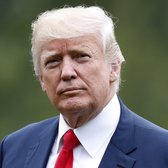In 2016, the Air Force had 1,143 fighter jets. The most recent count reported by the Congressional Research Service puts the number at 1,186, for a gain of 43 aircraft since President Donald Trump took office.
That total is pretty close to Trump's goal, and a slightly later tally than the one used by the Congressional Research Service suggests the goal has been met. The conservative Heritage Foundation shows 1,232 fighter jets.
But the count obscures a key concern.
"Air Force aircraft remain quite old," said the Heritage Foundation's Dakota Wood.
Wood, a senior defense researcher, credits Trump with supporting funding that has replaced aging planes and increased the percentage of the Air Force that is combat-ready.
Still, in 2018, the average age of a fighter or attack jet was 27 years. And according to Air Force data, in 2019 less than three-fourths of the fighter jet inventory was ready at a moment's call.
The Heritage Foundation's latest assessment found that even though the Air Force budget climbed by 25% since Trump took office, "the Air Force has had little measurable success in using that funding" to solve critical problems.
By the foundation's count, the Air Force has 951 "combat coded" fighters. It said 1,200 are needed.
We rate this a Compromise.

